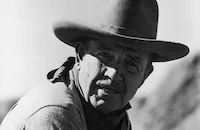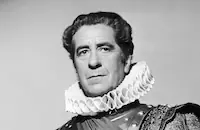The Roadhouse Murder

Brief Synopsis
Cast & Crew
J. Walter Ruben
Dorothy Jordan
Eric Linden
Rosco Ates
Purnell Pratt
Bruce Cabot
Film Details
Technical Specs

Synopsis
After New York cub reporter Charles "Chick" Brian is ridiculed by his editor for submitting an inaccurate story, he seeks solace with his girl friend, Mary Agnew. Because Mary's father, a police inspector, strongly disapproves of Chick, Mary is forced to meet secretly with the reporter. While driving in the country with Mary, Chick reveals his frustrations over his floundering career and his inability to provide amply for a wife. As they are driving home, a sudden rain storm floods the road and grounds Chick's convertible. Chick and Mary find refuge at the Lame Dog Inn, a delapidated roadhouse whose only occupants are Charles Spengler, an old porter, and one guest, Emil Brugger. While Chick and Mary are drying off, they hear a gunshot and a bumping noise in the room above them. After finding Spengler shot to death in the hallway, Chick and Mary burst into Brugger's room, interrupting the escape of thieves Fred Dykes and Louise Rand. At Louise's insistence, Fred resists killing the young couple and leaves through the window. As Chick examines Brugger's strangled corpse, Mary finds Louise's pocketbook with her name and address in it. Inspired by the scene, Chick tells Mary that he is going to launch his newspaper career by framing himself as the killer, then revealing the purse at the appropriate dramatic moment. Although reluctant, Mary helps Chick to plant evidence that will implicate him the crime and agrees to keep Louise's purse. As hoped, Agnew and his men connect Chick to the physical evidence found at the roadhouse and instigate a manhunt to find him. By mailing to his editor stories that he calls "The Diary of a Hunted Man," the fugitive Chick becomes an overnight newspaper celebrity. Eventually Chick shows up at Mary's home and is arrested by Agnew. During a rigorous interrogation, Agnew becomes convinced that Chick is innocent but is unable to extract the facts from him. At his trial, Chick cockily maintains his innocence and declares to the press that he will be presenting evidence that will clear him of all suspicion. When Fred, who has identified Mary from a newspaper photograph, reads Chick's announcement, he follows Mary to the courthouse and snatches Louise's purse from her. Without the purse, Chick is forced to plead for mercy, but in spite of Mary's self-sacrificing admission that she was with him at the inn, he is found guilty. After Mary accuses her father of causing Chick's downfall, Inspector Agnew receives a telephone tip from a fearful Louise. To protect herself, Louise lures Fred to her apartment and identifies him to the police, who then shoot him as he tries to escape. Finally free, a wiser Chick happily embraces Mary.

Director
J. Walter Ruben
Cast

Dorothy Jordan

Eric Linden

Rosco Ates
Purnell Pratt

Bruce Cabot
Phyllis Clare
Gustav Von Seyffertitz
Roscoe Karns
William Morris
Frank Sheridan
Carl Gerard

Robert Warwick
Crew

Film Details
Technical Specs

Articles
The Roadhouse Murder -
By Glenn Erickson

The Roadhouse Murder -
Quotes
Trivia
Notes
László Bus-Fekete's play was based on Maurice Level's novel. Copyright records credit both works as sources for this film. RKO borrowed Dorothy Jordan from M-G-M for the production. Film Daily news items add David Landau, Creighton Chaney, Julie Haydon, Jacques de Bujac, Alfred James, Charles Quigley, Sammy Fuller, Shirley Chambers and William Halligan to the cast, but their participation in the final film has not been confirmed. According to an RKO studio memorandum, this picture cost $117,713 to produce and netted a profit of $21,000.














